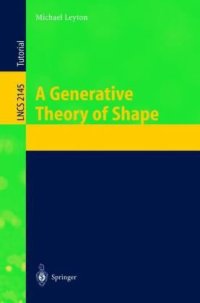
Ebook: A Generative Theory of Shape
Author: Michael Leyton
- Genre: Computers
- Tags: Image Processing and Computer Vision, Computer Graphics, Geometry, Group Theory and Generalizations, Computer-Aided Engineering (CAD CAE) and Design
- Series: Lecture Notes in Computer Science 2145
- Year: 2001
- Publisher: Springer-Verlag Berlin Heidelberg
- City: Berlin; New York
- Edition: 1
- Language: English
- pdf
The purpose of this book is to develop a generative theory of shape that has two properties we regard as fundamental to intelligence –(1) maximization of transfer: whenever possible, new structure should be described as the transfer of existing structure; and (2) maximization of recoverability: the generative operations in the theory must allow maximal inferentiability from data sets. We shall show that, if generativity satis?es these two basic criteria of - telligence, then it has a powerful mathematical structure and considerable applicability to the computational disciplines. The requirement of intelligence is particularly important in the gene- tion of complex shape. There are plenty of theories of shape that make the generation of complex shape unintelligible. However, our theory takes the opposite direction: we are concerned with the conversion of complexity into understandability. In this, we will develop a mathematical theory of und- standability. The issue of understandability comes down to the two basic principles of intelligence - maximization of transfer and maximization of recoverability. We shall show how to formulate these conditions group-theoretically. (1) Ma- mization of transfer will be formulated in terms of wreath products. Wreath products are groups in which there is an upper subgroup (which we will call a control group) that transfers a lower subgroup (which we will call a ?ber group) onto copies of itself. (2) maximization of recoverability is insured when the control group is symmetry-breaking with respect to the ?ber group.
The purpose of the book is to develop a generative theory of shape that has two properties regarded as fundamental to intelligence - maximizing transfer of structure and maximizing recoverability of the generative operations. These two properties are particularly important in the representation of complex shape - which is the main concern of the book. The primary goal of the theory is the conversion of complexity into understandability. For this purpose, a mathematical theory is presented of how understandability is created in a structure. This is achieved by developing a group-theoretic approach to formalizing transfer and recoverability. To handle complex shape, a new class of groups is developed, called unfolding groups. These unfold structure from a maximally collapsed version of itself. A principal aspect of the theory is that it develops a group-theoretic formalization of major object-oriented concepts such as inheritance. The result is a mathematical language that brings interoperability into the very foundations of geometry. The book gives extensive applications of the theory to CAD/CAM, human and machine vision, robotics, software engineering, and physics. In CAD, lengthy chapters are presented on mechanical and architectural design. For example, using the theory of unfolding groups, the book works in detail through the main stages of mechanical CAD/CAM: part-design, assembly and machining. And within part-design, an extensive algebraic analysis is given of sketching, alignment, dimensioning, resolution, editing, sweeping, feature-addition, and intent-management. In robotics, several levels of analysis are developed for manipulator structure and kinematics. In software, a new theory is given of the principal factors such as text and class structure, object creation and modification, as well as inheritance and hierarchy prediction. In physics, a new theory is given of the conservation laws, and motion decomposition theorems in classical and quantum mechanics.